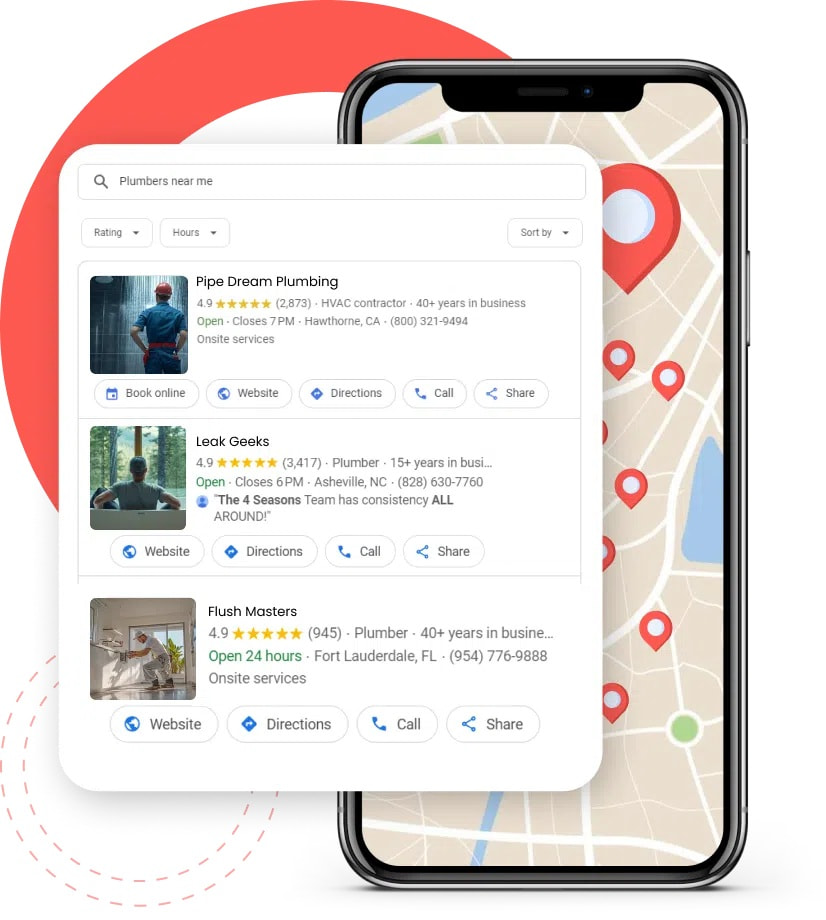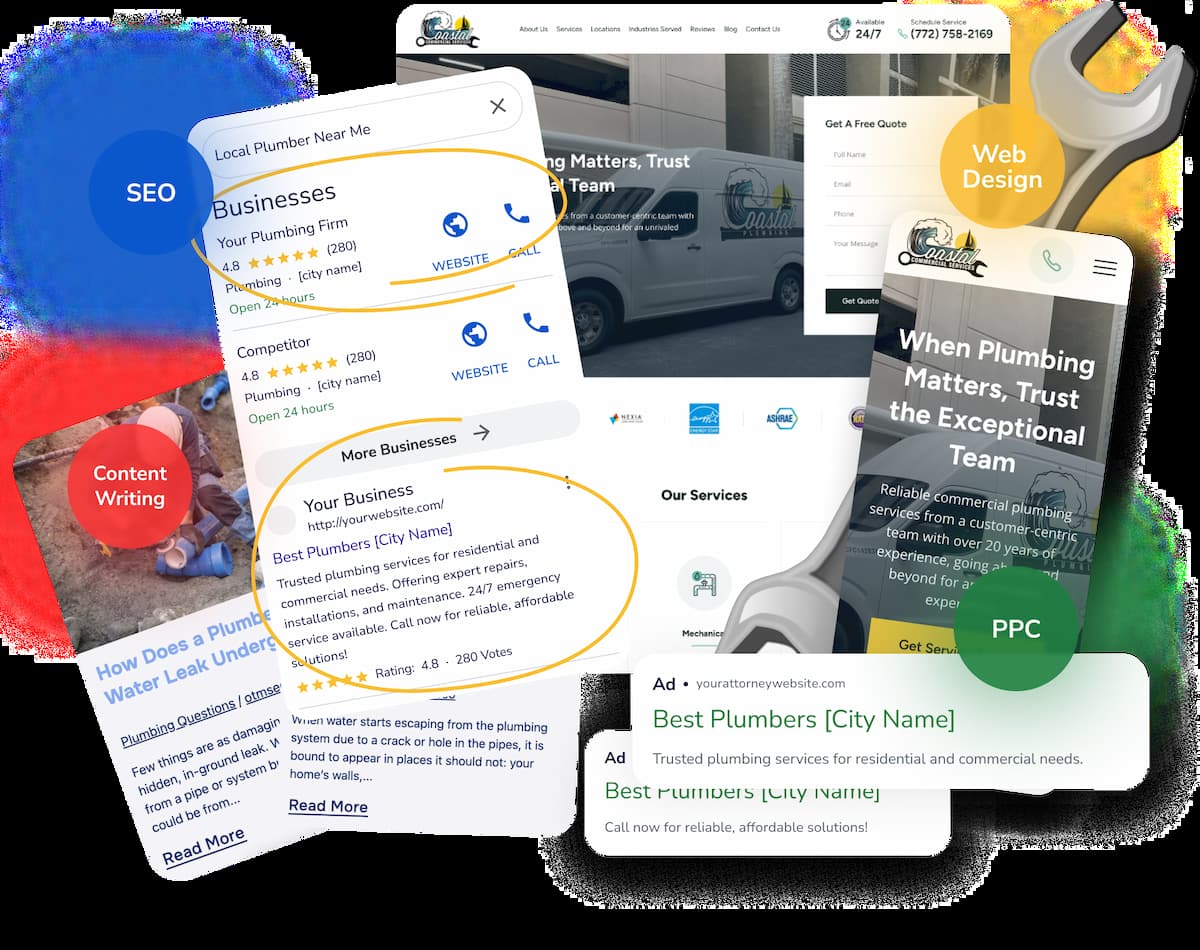For local plumbing companies, email marketing for plumber local businesses is a direct and cost-effective way to build customer relationships, encourage repeat business, and generate qualified leads. Unlike generic advertising, it allows you to send targeted and useful content directly to homeowners who already know your brand, making it one of the most effective marketing methods available.
This guide describes five email campaigns that are effective for plumbing firms, including clear strategies for growing a subscriber list, generating interesting content, and measuring outcomes. These approaches can assist both small local businesses and major service providers in converting subscribers into repeat consumers.
Table of Contents
How Can Plumbers Use Email Marketing?
Think email marketing is just for big brands?
Think again. For plumbers, it’s one of the best tools to keep your truck busy and build a reputation as the local expert.
Instead of just blasting out coupons, use it to teach homeowners about simple preventative maintenance. A quick tip on avoiding frozen pipes in winter builds way more trust than a generic sale.
You can also use it to stay top-of-mind with seasonal reminders — like getting furnaces checked in the fall or sump pumps tested before spring rains. Remember that the easiest approach to get a review is to send a brief email to a satisfied customer. You’ll be the first person they think of when the next emergency occurs.
To get the most out of your efforts, consider how combining email with excellent content strategies may enhance growth — something covered in detail in How to Use Content + Email Marketing to Grow Your Business.
How Email Marketing Helps Plumbing Businesses
For a plumbing company, email marketing for plumber local businesses isn’t just another task — it’s one of the most effective ways to keep existing customers, encourage repeat business from past clients, and get more long-term value from every job.
Homeowners Need Plumbing More Than Once
Customers often face multiple plumbing issues over the years. A small repair today can lead to a bigger service later. Sending regular emails keeps your business top of mind, so they reach out to you first.
You’re Reaching People Who Already Trust You
Your email list isn’t made up of cold leads — it’s customers who already hired you and know your work. Staying connected with them is more effective and less expensive than constantly finding new clients.
It Positions You as the Expert
When you send useful advice — like how to avoid a clogged drain or prep pipes for winter — you’re not just selling; you’re proving you know your stuff. This builds trust and solidifies your reputation as the reliable local expert, not just another option.
Affordable with Strong ROI
Email marketing tools are inexpensive and allow you to reach a large number of local customers for a small monthly cost. This makes it one of the most cost-effective marketing channels available.
How to Build a Plumbing Email List
Every successful plumbing email marketing strategy begins with the appropriate foundation — a permission-based list of subscribers who want to hear from you. Collecting addresses in a transparent manner not only assures compliance but also generates an engaged audience that is more likely to respond to your offerings.
Use Customer Touchpoints
The best time to capture email addresses is during direct customer interactions. These warm leads already know your business and are most likely to subscribe.
The Point of Sale (Digital & In-Person)
Integrate an email sign-up field into your service estimate forms, work orders, and digital invoices. Crucially, train your technicians to politely ask for permission after a job is completed.
A simple script like, “Would you like to receive our seasonal maintenance tips and exclusive offers via email?” is highly effective.
Post-Service Follow-up
Once the job is done, an automated follow-up text or email is a perfect opportunity. Include a quick link for them to join your list for future maintenance reminders. It’s a no-pressure way to stay in touch.
Optimize Your Website for Conversion
Your website is your always-open storefront and your most powerful lead generation tool.
Place a simple, clear opt-in form like “Join Our List for Plumbing Tips” in your website’s header or footer, making it visible on every page.
This is your most effective tool for converting visitors into subscribers. Offer a valuable, free resource in exchange for an email address.
Crucial Tip: Your lead magnet must solve a common problem for homeowners, such as:
- “5 DIY Tips to Prevent Costly Plumbing Emergencies.”
- “Your Ultimate Guide to Maintaining Your Garbage Disposal.”
- “Seasonal Plumbing Checklist for Homeowners.”
Promote Your List on Social Media
Your social media channels are ideal for reaching a broader local audience and driving traffic to your sign-up forms.
- Promote Your Lead Magnet: Create posts that highlight the value of your free guide (e.g., “Stop clogged drains for good! Download our free guide.”) and link directly to your sign-up page;
- Run Exclusive Social Media Offers: Encourage sign-ups by promoting subscriber-only discounts or early access to services on your Facebook page or Instagram profile.
What to Send: 5 Email Types for Your Plumbing Business
Your emails should provide useful information while also including subtle promotional messages.
The Welcome & Education Series
Goal: Build trust and deliver immediate value.
When someone signs up for your emails — maybe after you’ve done a job for them or they grabbed your free guide — don’t just send one email and call it done. Set up a few automatic emails that welcome them.
Think of it like this: use this series to properly introduce your business, explain how you can help them, and share useful tips. It’s your chance to start building a relationship before they even need to call you again.
Example flow:
- Email 1: Thanks + instant delivery of your lead magnet (e.g., “5 Tips to Prevent Plumbing Emergencies”);
- Email 2: Introduce your team with photos and bios — highlight experience and certifications;
- Email 3: Share a customer success story or video testimonial;
- Email 4: Offer a limited-time discount on their first service.
This series turns new contacts into familiar faces before they even need you.
Seasonal Maintenance Reminders
Goal: Prevent problems and schedule calls in advance.
Homeowners appreciate — and need — proactive tips tailored to the time of year. These emails position you as an expert while generating service calls during slower periods.
Examples:
- Spring: Summer irrigation setup, gutter cleaning, and Sump Pump checks;
- Fall: Winterization tips, pipe insulation, and water heater servicing;
- Holiday Season: Advice on handling guest loads and garbage disposal care.
Always include a clear CTA like: “Schedule your pre-winter inspection today →”
Post-Service Follow-Up & Review Requests
The Goal: Keep customers coming back and get more five-star reviews.
Right after you finish a job, set up an automatic email to go out. This isn’t just about saying thanks — it’s a chance to make sure everything went well and gently ask for a review if they’re happy.
A good follow-up email does three things:
- Says thanks for their business;
- Checks that they’re happy with the work;
- Makes it easy to leave a review on Google or Yelp.
Example template:
“Hi [Customer Name], thanks for choosing us for your recent repair! We hope everything is working perfectly. If you have a minute, we’d really appreciate you leaving a quick review — it helps other homeowners find reliable service too.”
[Leave a Review]
Re-engagement Campaigns
Goal: Win back past customers.
If a client hasn’t booked in over a year, they might have forgotten you — or gone to a competitor. A friendly, incentive-based email can bring them back.
Try this subject line: “We miss you! Here’s 10% off your next service.”
Pair the offer with a gentle reminder of the services you offer and a prompt to schedule maintenance.
Promotional & Urgent Offers
Goal: Fill your schedule during slow periods.
Use email to promote limited-time offers that create urgency.
Examples:
- “$50 Off Water Heater Flush This Month Only.”
- “Emergency Drain Cleaning Available — Book Now!”
- “Free Second Opinion on Any Repair Quote.”
These emails work best when targeted to segments of your list — for example, sending water heater offers only to customers with older units.
Best Practices in Email Marketing for Plumber Local Businesses
To make email campaigns effective, there are a few important points to follow. These practices help improve communication with customers, build trust, and generate more service calls.
Make Sure Your Emails Work on Phones
You probably already know this: practically everyone reads email on their phone. So if your message is crowded, the font is small, or the buttons are tough to hit, consumers will just delete it.
The solution is simple: stick to a clean, single-column style, utilize larger font sizes, and make your action buttons huge and easy to click.
Here’s an expert tip: always send yourself a test email and open it on your phone. It takes two minutes and prevents you from sending anything that looks unprofessional.
Personalize When You Can
People ignore emails that look like they were sent to a thousand strangers. Use the customer’s name, and better yet, reference their last service.
Did you install their water heater last year? Send a maintenance reminder.
Fix a drain? Follow up with a tip to keep it clear. It shows you remember them, and that builds trust.
Clear Call-to-Action (CTA)
Every email you send should serve a single, essential purpose. What do you want the receiver to do after reading? Your entire email should be designed to direct them to this action.
Your CTA must be visually prominent and hyperlinked to the correct landing page. Use action-oriented verb-based text that creates a sense of urgency or benefit. Instead of a vague “Click Here,” use specific, compelling CTAs like:
- “Schedule Your Fall Check-Up.”
- “Download Your Free Guide.”
- “Leave a Review.”
Be Consistent
The key to good email isn’t frequency — it’s consistency. Stick to a regular schedule, whether that’s every week or every season. It keeps you on your audience’s radar and builds trust, so they see you as a reliable resource, not just someone who pops up when you want something.
Track Your Results
One of the main advantages of email is that you can measure performance. Focus on two important metrics: open rates, which show if subject lines are effective, and click-through rates, which indicate how well people interact with your content.
Most email platforms provide this data in simple dashboards. Use the information to test and adjust your campaigns.
Conclsuion
In the plumbing trade, the strongest pipe connections are the ones that don’t leak — and the same principle applies to customer relationships. Email marketing for plumber local businesses is the tool that keeps those connections strong, ensuring your company is top of mind whenever a plumbing issue arises.


